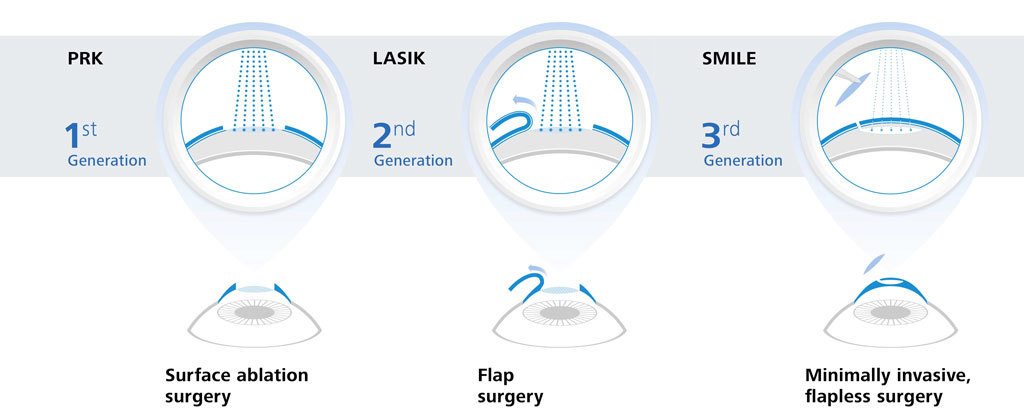How Does SMILE Eye Surgery Compare To LASIK And PRK?
How Does SMILE Eye Surgery Compare To LASIK And PRK?
Blog Article
Authored By-Dreyer Sander
If you've been considering SMILE eye surgical treatment, you might ask yourself how it compares to LASIK and PRK. Each treatment has its very own collection of advantages and factors to consider. From quicker recovery times to potential dangers, there are vital differences you must recognize before deciding. Comprehending these differences will certainly help you make an educated selection that aligns with your specific needs and expectations. Interested to know even more about exactly how these treatments compare thoroughly? Keep on checking out to obtain an extensive understanding of SMILE, LASIK, and PRK.
SMILE Eye Surgical Procedure Overview
If you're taking into consideration SMILE eye surgical treatment, you'll discover it to be a minimally intrusive treatment with a fast healing time. During please click the next website (Tiny Incision Lenticule Removal), a laser is used to produce a small, accurate cut in the cornea to get rid of a little piece of tissue, reshaping it to fix your vision. This differs from LASIK, where a flap is produced, and PRK, where the outer layer of the cornea is completely gotten rid of.
Among the crucial benefits of SMILE is its minimally invasive nature, causing a faster healing procedure and less pain post-surgery. The recovery time for SMILE is relatively quick, with several patients experiencing enhanced vision within a day or two. This makes it a prominent selection for those looking for a practical and reliable vision improvement procedure. Additionally, SMILE has actually been shown to have a reduced risk of completely dry eye syndrome contrasted to LASIK, making it a positive option for individuals worried concerning this potential adverse effects.
Distinctions Between SMILE, LASIK, and PRK
When comparing SMILE, LASIK, and PRK eye surgeries, it is very important to understand the distinct strategies made use of in each treatment for vision modification.
SMILE (Little Laceration Lenticule Extraction) is a minimally invasive treatment that entails developing a little laceration to draw out a lenticule from the cornea, reshaping it to correct vision.
LASIK (Laser-Assisted In Situ Keratomileusis) entails developing a slim flap on the cornea, making use of a laser to improve the underlying tissue, and after that rearranging the flap.
PRK (Photorefractive Keratectomy) removes the outer layer of the cornea before reshaping the tissue with a laser.
The main difference lies in the means the cornea is accessed and treated. SMILE is flapless, making it an excellent option for people with thin corneas or those associated with get in touch with sporting activities. LASIK offers fast aesthetic healing due to the flap creation, however it may posture a higher danger of flap-related problems. PRK, although having Cost Of LASIK For Astigmatism , avoids flap-related problems entirely.
Recognizing these variations is vital in choosing one of the most appropriate procedure for your vision adjustment needs.
Advantages And Disadvantages Comparison
To review the advantages and drawbacks of SMILE, LASIK, and PRK eye surgical treatments, it's vital to think about the details advantages and potential limitations of each procedure. SMILE surgery offers the benefit of a minimally invasive procedure, with a smaller laceration and possibly quicker healing time contrasted to LASIK and PRK. It likewise decreases the threat of dry eye post-surgery, a typical adverse effects of LASIK. Nevertheless, LASIK For High Astigmatism might have constraints in treating higher levels of nearsightedness or astigmatism contrasted to LASIK.
LASIK surgery supplies rapid aesthetic recovery and minimal pain throughout the treatment. It's highly efficient in treating a vast array of refractive mistakes, consisting of nearsightedness, hyperopia, and astigmatism. Yet, LASIK carries a threat of flap problems, which can impact the corneal structure.
PRK eye surgery, while not as preferred as LASIK, prevents producing a corneal flap, lowering the risk of flap-related issues. It appropriates for individuals with thin corneas or irregular corneal surface areas. However, PRK has a much longer recovery time and might include extra pain throughout the recovery procedure.
Conclusion
So, when it comes to picking between SMILE, LASIK, and PRK, consider it like choosing the best set of shoes. SMILE is like a sleek, comfortable pair of sneakers - quick and easy.
LASIK is extra like stylish high heels - showy and quick, however with some prospective risks.
PRK is like tough treking boots - trustworthy and sturdy, but requiring a bit even more effort and time.
Eventually, the very best selection depends upon your specific demands and preferences.
